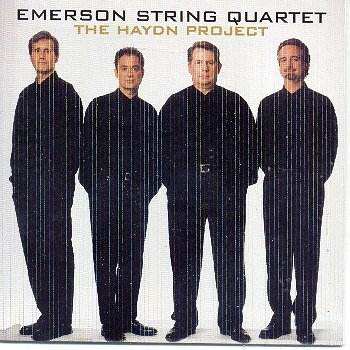If the prospect of six Haydn string quartets in one evening might on paper seem overkill, the reality was very different. There was actually a real sense of disappointment that there was no more to come as the quartet embarked on the last instalment of the evening.
The New York-based Emerson Quartet has built up an enviable reputation in recent years for their combination of virtuosity and musicianship. This concert was the second instalment of a tripartite celebration of their twenty-fifth anniversary (they traversed the six Bartók Quartets on Sunday and will present Beethoven's three 'Razumovsky' Quartets on Thursday).
There is no doubting the polished technique of their Haydn performances: ensemble was almost preternaturally tight and the members bounced themes back and forth between each other with unforced ease. More than this, they exuded the facet that Haydn needs most: character, and it was this that made the evening enthralling from first note to last. That the two violins could (and did) equally take the first violin part was merely evidence of how they work as an integrated musical unit: So, Philip Setzer played the first violin in the 1st, 5th and 6th quartets of the evening, whilst Eugene Drucker played the 2nd-4th.
The six quartets were presented in chronological order. Most had nicknames, although I had never heard of Op. 20 No.5 in F minor being referred to as the 'Handel theme' Quartet before. The Op. 20 quartets represented a new stage in Haydn's quartet writing, representing an expansion of what he had previously achieved in the fledgling genre. Setzer's violin tone was almost Romantic in the first theme. By beginning with a minor key quartet (one with a first movement marked 'moderato' to boot) there seemed to be a statement of intent which set forth loud and clear that they are serious about this music. Traits which were to be symptomatic of their approach surfaced in this quartet: the dialogues between instruments (here between the two violins in particular); the inability of any member to play even the most repetitious accompaniment routinely; the tremendous textural elucidation; the complete structural grasp. The final 'Fuga a due soggetti' revealed the Emerson's contrapuntal skills at their finest, here fuelled by real drive and rhythmic energy.
In contrast, the jolly account of the E flat major Quartet, Op. 33 No. 2, 'Joke', was characteristic of the jaunty Haydn we all know and love ('cheeky' is the only word for the finale). It should be remembered that this is a perfectly constructed piece also (the Op. 33 quartets had, after all, prompted Mozart to return to quartet writing after an extended gap). The second movement Scherzo was typical of the Emerson's refusal to treat Haydn with kid gloves: more a robust, open-air thigh slapping Austrian dance than music for the concert hall. The slow movements of both quartets were models of their kind, the first violin's ornamentation in Op. 20 No. 5 being exemplary, the use of silence in Op. 33 No. 2 gripping.
The next two quartets of the concert were two of Haydn's most famous: the 'Lark' and the 'Rider'. The ostensibly easy invention of this music belies a multitude of subtleties, and it was a credit to the quartet that tempi were always flowingly natural. The moto perpetuo of the last movement of the 'Lark' was thrillingly done, the first movement of the 'Rider' (which followed immediately) capitalising on this mood and coming across as a dramatic tour-de-force. The viola player took full advantage of his placement on the outside (opposite the first violin) to project his lines. All players possessed the requisite power and drive for the final movement of the 'Rider'.
After the second interval, Op. 76 No. 2 ('Fifths'), we heard the last of Haydn's three completed D minor quartets. By this time the differences between Drucker and Setzer were beginning to set in: here Setzer was more in tune than Drucker, but was lower in power. A highlight was the finale, with the first violin throwing away his phrases to delightful effect. Finally, a quartet really and truly without a nickname, Op. 77 No. 1 in G. Far from being an exhausted (and exhausting) end to the evening, it was a triumph. All of the Emerson's positive qualities seemed to gel to an even greater extent on this performance. Most notable of all was the concentration of the Adagio. The spirited finale brought to an end a concert which will dwell long in my memory.
It remains only to add that the Emerson's Haydn can be enjoyed on their set of quartets on DG 471 327-2 (see below).
Colin Clarke
The Haydn Project on two DG discs 471 327-2 was recorded over a period of six months from December 2000 To May 2001. Typically, the playing is immaculate - in fact, these are the best played recordings I have heard but I wonder whether the Emerson's have entirely the right temperament to play this music. Unlike both their Bartok and Shostakovich cycles, which were masterly surveys, this one suffers from a closeted view of Haydn's own compositional development: there seems minimal understanding of the increasing scale of the works so the Op.77 no.1, which in part anticipates Mozart and Beethoven in its complex construction of large-scale sonata movements, seems almost identically played in texture to the earliest in this set, the Op.20 no.5.
There is, however, a beautiful clarity to their phrasing and as CC points out above the difference in tone between Setzer and Drucker can occasionally seem stark. Drucker perhaps brings greater warmth to the slow movements (his tone is darker, partly because he plays a 1686 Stradivarius against Setzer's 1999 Zygmuntowicz). As ever, Dutton and Finckel bring finesse to their playing and a glowing sound world - at once brooding as its is elemental.
These are not revelatory readings in the way, say, the Lindsey's approach these works but they are undeniably impressive performances.

Marc Bridle
 Return to:
Return to: